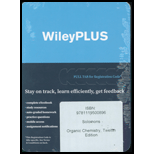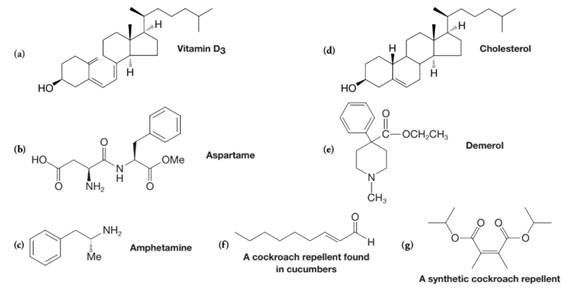
ORGANIC CHEMISTRY-WILEYPLUS ACCESS PKG.
12th Edition
ISBN: 9781119766919
Author: Solomons
Publisher: WILEY
expand_more
expand_more
format_list_bulleted
Concept explainers
Textbook Question
Chapter 2, Problem 30P
Identify all of the

Expert Solution & Answer
Want to see the full answer?
Check out a sample textbook solution
Students have asked these similar questions
Choose the Lewis structure for the compound below:
H2CCHOCH2CH(CH3)2
HH
H
:d
H
H
H C.
Η
H
H
HH
H
H
H
H.
H
H
H
HH
H
H
H
H
H-
H
H
H
C-H
H
H
HHHH
Each of the highlighted carbon atoms
is connected to
hydrogen atoms.
く
Complete the reaction in the drawing area below by adding the major products to the right-hand side.
If there won't be any products, because nothing will happen under these reaction conditions, check the box under the drawing area
instead.
Note: if the products contain one or more pairs of enantiomers, don't worry about drawing each enantiomer with dash and wedge
bonds. Just draw one molecule to represent each pair of enantiomers, using line bonds at the chiral center.
More...
No reaction.
Explanation
Check
O
+
G
1. Na O Me
Click and drag to start
drawing a structure.
2. H
+
2025 McGraw Hill LLC. All Rights Reserved. Terms of Use | Privacy Center | Accessibility
000
Ar
P
Chapter 2 Solutions
ORGANIC CHEMISTRY-WILEYPLUS ACCESS PKG.
Ch. 2 - Practice Problem 2.1
Propose structures for two...Ch. 2 - Prob. 2PPCh. 2 - Prob. 3PPCh. 2 - Prob. 4PPCh. 2 - Prob. 5PPCh. 2 - Practice Problem 2.6
Using a three-dimensional...Ch. 2 - Practice Problem 2.7
Trichloromethane (, also...Ch. 2 - Prob. 8PPCh. 2 - Prob. 9PPCh. 2 - Practice Problem 2.10
Write bond-line structural...
Ch. 2 - Practice Problem 2.11 Although we shall discuss...Ch. 2 - Practice Problem 2.12 Write bond-line structural...Ch. 2 - Prob. 13PPCh. 2 - Practice Problem 2.14
One way of naming ethers is...Ch. 2 - Practice Problem 2.15 Eugenol is the main...Ch. 2 - Practice Problem 2.16
One way of naming amines is...Ch. 2 - Practice Problem 2.17 Which amines in Practice...Ch. 2 - Prob. 18PPCh. 2 - Prob. 19PPCh. 2 - Practice Problem 2.20
Write bond-line formulas for...Ch. 2 - Practice Problem 2.21
Write bond-line formulas for...Ch. 2 - Practice Problem 2.22
Write bond-line formulas for...Ch. 2 - Prob. 23PPCh. 2 - Practice Problem 2.24 Write another resonance...Ch. 2 - Prob. 25PPCh. 2 - Practice Problem 2.26
Which compound would you...Ch. 2 - Practice Problem 2.27 Arrange the following...Ch. 2 - Prob. 28PPCh. 2 - Prob. 29PCh. 2 - Identify all of the functional groups in each of...Ch. 2 - 2.31 There are four alkyl bromides with the...Ch. 2 - Prob. 32PCh. 2 - Classify the following alcohols as primary,...Ch. 2 - 2.34 Classify the following amines as primary,...Ch. 2 - Prob. 35PCh. 2 - Identify all of the functional groups in Crixivan,...Ch. 2 - 2.37 Identify all of the functional groups in...Ch. 2 - 2.38 (a) Indicate the hydrophobic and hydrophilic...Ch. 2 - Hydrogen fluoride has a dipole moment of 1.83 D;...Ch. 2 - 2.40 Why does one expect the cis isomer of an...Ch. 2 - Prob. 41PCh. 2 - Prob. 42PCh. 2 - Prob. 43PCh. 2 - 2.44 Consider each of the following molecules in...Ch. 2 - True or false: For a molecule to be polar, the...Ch. 2 - 2.46 Which compound in each of the following...Ch. 2 - Prob. 47PCh. 2 - The IR spectrum of propanoic acid (Fig. 2.16)...Ch. 2 - Prob. 49PCh. 2 - Write structural formulas for four compounds with...Ch. 2 - There are four amides with the formula C3H7NO. (a)...Ch. 2 - Prob. 52PCh. 2 - Prob. 53PCh. 2 - Prob. 54PCh. 2 - Prob. 55PCh. 2 - 2.56 Compound C is asymmetric, has molecular...Ch. 2 - 2.57 Examine the diagram showing an -helical...Ch. 2 - Prob. 1LGPCh. 2 - Prob. 2LGPCh. 2 - Prob. 3LGPCh. 2 - Consider the molecular formula C4H8O2. Predict...Ch. 2 - Consider the molecular formula C4H8O2. If any of...Ch. 2 - Prob. 6LGPCh. 2 - Consider the molecular formula.
7. Pick five...Ch. 2 - Prob. 8LGP
Additional Science Textbook Solutions
Find more solutions based on key concepts
Show the steps in the synthesis of the tetrapeptide in Problem 34, using Merrifields method.
Organic Chemistry (8th Edition)
18. A 1.0 kg block is attached to a spring with spring constant 16 N/m. While the block is sitting at rest, a s...
Physics for Scientists and Engineers: A Strategic Approach, Vol. 1 (Chs 1-21) (4th Edition)
4. What five specific threats to biodiversity are described in this chapter? Provide an example of each.
Biology: Life on Earth (11th Edition)
Choose the best answer to each of the following. Explain your reasoning. What would stars be like if carbon had...
Cosmic Perspective Fundamentals
Flask A contains yeast cells in glucose-minimal salts broth incubated at 30C with aeration. Flask B contains ye...
Microbiology: An Introduction
The amount of work that the water molecule did on the balloon must be calculated. Concept Introduction : Expans...
Living By Chemistry: First Edition Textbook
Knowledge Booster
Learn more about
Need a deep-dive on the concept behind this application? Look no further. Learn more about this topic, chemistry and related others by exploring similar questions and additional content below.Similar questions
- Draw a tetramer of this alternating copolymer.arrow_forwardH I T H HH H -H C. H- Identify and select all structures below that represent a constitutional isomer(s) of the compound shown above. H- H CIH H H H HHHH H H 0 ·H H– 冊 CH CHI HH C- H- H H- H H A. H H C H H- -H HH H B. H- -H D. H H H H • H -H E. -H H H HICH T HHH F. H-arrow_forwardPolylactic acid (shown below) is a biodegradable polymer used for food packaging. Identify the monomer(s) used in the production of this polymer using a condensation process.arrow_forward
- Draw the product of the reaction shown below. Ignore small byproducts that would evaporate pleasearrow_forwardPoly(ethylene adipate) is a biodegradable polyester (shown below). Identify the type of polymerization process used in the production of this polymer.arrow_forwardPolymers may be composed of thousands of monomers. draw two repeat units(dimer) of the polymer formed in this reaction. assume there are hydrogen atoms on the two ends of the dimer. ignore inorganic byproducts pleasearrow_forward
- Draw the product of the reaction shown below. Use a dash or wedge bond to indicate stereochemistry of substituents on asymmetric centers, Ignore inorganic byproductsarrow_forwardDraw the product of this reaction please. Ignore inorganic byproductsarrow_forwardOne of the pi molecular orbitals of 1,3-butadiene (CH2=CHCH=CH2) is shown below. Please identify the number of nodal planes perpendicular to the bonding axisarrow_forward
- Draw the monomers required to synthesize this condensation polymer please.arrow_forwardProvide the correct systematic name for the compound shown here. Please take into account the keyboard options belowarrow_forwardcurved arrows are used to illustrate the flow of electrons. using the provided starting and product structures, draw the curved electron-pushing arrows for the following reaction or mechanistic step(s)arrow_forward
arrow_back_ios
SEE MORE QUESTIONS
arrow_forward_ios
Recommended textbooks for you
- Chemistry: Matter and ChangeChemistryISBN:9780078746376Author:Dinah Zike, Laurel Dingrando, Nicholas Hainen, Cheryl WistromPublisher:Glencoe/McGraw-Hill School Pub Co
 Introductory Chemistry: A FoundationChemistryISBN:9781337399425Author:Steven S. Zumdahl, Donald J. DeCostePublisher:Cengage Learning
Introductory Chemistry: A FoundationChemistryISBN:9781337399425Author:Steven S. Zumdahl, Donald J. DeCostePublisher:Cengage Learning  Chemistry for Today: General, Organic, and Bioche...ChemistryISBN:9781305960060Author:Spencer L. Seager, Michael R. Slabaugh, Maren S. HansenPublisher:Cengage Learning
Chemistry for Today: General, Organic, and Bioche...ChemistryISBN:9781305960060Author:Spencer L. Seager, Michael R. Slabaugh, Maren S. HansenPublisher:Cengage Learning Chemistry & Chemical ReactivityChemistryISBN:9781337399074Author:John C. Kotz, Paul M. Treichel, John Townsend, David TreichelPublisher:Cengage Learning
Chemistry & Chemical ReactivityChemistryISBN:9781337399074Author:John C. Kotz, Paul M. Treichel, John Townsend, David TreichelPublisher:Cengage Learning Chemistry & Chemical ReactivityChemistryISBN:9781133949640Author:John C. Kotz, Paul M. Treichel, John Townsend, David TreichelPublisher:Cengage Learning
Chemistry & Chemical ReactivityChemistryISBN:9781133949640Author:John C. Kotz, Paul M. Treichel, John Townsend, David TreichelPublisher:Cengage Learning

Chemistry: Matter and Change
Chemistry
ISBN:9780078746376
Author:Dinah Zike, Laurel Dingrando, Nicholas Hainen, Cheryl Wistrom
Publisher:Glencoe/McGraw-Hill School Pub Co

Introductory Chemistry: A Foundation
Chemistry
ISBN:9781337399425
Author:Steven S. Zumdahl, Donald J. DeCoste
Publisher:Cengage Learning


Chemistry for Today: General, Organic, and Bioche...
Chemistry
ISBN:9781305960060
Author:Spencer L. Seager, Michael R. Slabaugh, Maren S. Hansen
Publisher:Cengage Learning

Chemistry & Chemical Reactivity
Chemistry
ISBN:9781337399074
Author:John C. Kotz, Paul M. Treichel, John Townsend, David Treichel
Publisher:Cengage Learning

Chemistry & Chemical Reactivity
Chemistry
ISBN:9781133949640
Author:John C. Kotz, Paul M. Treichel, John Townsend, David Treichel
Publisher:Cengage Learning
Lipids - Fatty Acids, Triglycerides, Phospholipids, Terpenes, Waxes, Eicosanoids; Author: The Organic Chemistry Tutor;https://www.youtube.com/watch?v=7dmoH5dAvpY;License: Standard YouTube License, CC-BY